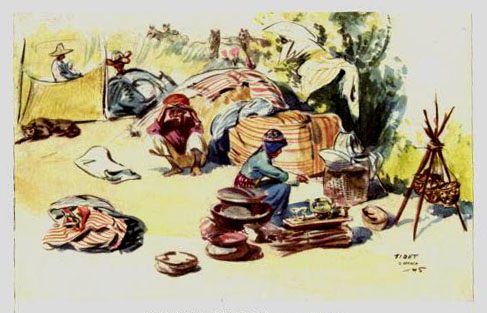

In rapid action sketches of people, spot the head with a light oval, drop a light line down the spinal column extending it to the foot upon which the action pivots, and then having spotted in both feet draw the figure from the feet upwards, finishing the head last. This procedure will place your people solidly in their surroundings, keep your proportions accurate, and prevent the drawing from running off the page.
Having completed the pencil outline, you can - if time is limited - make very light colored pencil notes on the sketch, filing in just enough to sharpen your observation and stimulate your memory. Sketch as lightly as possible at all times, saving your good hard, sharp blacks for accents after you have completed the watewr color at some later date. In this way you can cover more ground and secure a greater number of sketches. It will also afford you the opportunity to edit the material more carefully and emphasize things which might otherwise have been overlooked had you painstakingly finished the sketch on the spot. Another advantage of this procedure is the chance to incorporate one or two very rapid small sketches to augment a highly polished painting, thereby giving the completed folio a feeling of sponaneity.
Make your sketches suit your market. A factual magazine will usually show a preference for literal pictures - save your sketchy drawings for the arty magazines.
This matter of selling magazines is a tricky one. To acquaint yourself with your intended market, read and study it carefully and pick your subject matter to suit the editorial slant, keeping the material simple enough to hold the interest of the general reader.
There are a number of simple devices that can be used to accomplish this. One of the simplest is to switch an old, hackneyed idea. Take a situation which is normally a masculine trait or occupation and then look for its feminine counterpoint. That is, slant the idea so that it is of interest to women bt showing the feminine side of the situation. Another device is to glamorize a seemingly prosaic occupation or dramatize a commonplace situation. This can be switched by humanizing a glamorous occupation. (A story on a circus showing the day-to-day activities of the roustabouts would fall into this category.) Then there is the simple expedient of tieing up an old and time-tested idea to some current event, trend or invention.
Having decided upon your subject matter, follow any and all leads - sketching constantly. Never pass up the slightest excuse for a picture - the situation that appears to hold the least promise may prove to be the pivotal sketch upon which to hang the entire series, or it may start you off on a fresh track.
The number of sketches you make or submit will vary with the subject matter. Twenty or thirty pictures should allow an editor ample material from which to select. These should be numbered and an explanatory caption included covering each sketch. It is also a good idea to include a short, factual story or note of 300 to 500 words.
And don't forget to include return postage along with your name and address!
THE END ******************************************